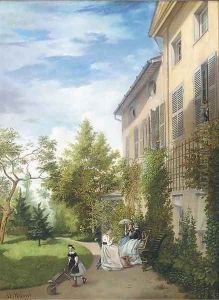Adolphe Hamel Paintings
Adolphe Hamel was a Swiss painter and watercolorist, born in 1824 in Geneva, Switzerland. His work primarily consisted of landscapes, genre scenes, and portraits. Hamel was part of the 19th-century European art movement, and though not as widely known as some of his contemporaries, his work contributed to the Swiss artistic tradition of the period.
Hamel received his early training in art in his hometown of Geneva, which at the time was a hub for artistic innovation and had a thriving community of artists. He furthered his education by traveling to Paris, where he was exposed to the works of the French masters. This exposure influenced his artistic style, which combined the precision of the Swiss painting tradition with some of the freer brushwork and color use found in French painting.
Throughout his career, Hamel exhibited his work in various Swiss and international art shows, including the prestigious Paris Salon, which was the official art exhibition of the Académie des Beaux-Arts in Paris. His landscapes often depicted the Swiss countryside, featuring the Alps, lakes, and rural scenes, capturing the majestic natural beauty of his homeland with a romantic sensibility.
Hamel's portraits and genre scenes, on the other hand, reflected his interest in the daily lives of people, their customs, and their environments. His works in these genres are characterized by a keen attention to detail, as well as an empathy for his subjects that added depth to his depictions.
Adolphe Hamel continued to paint and contribute to the Swiss art scene until his death in 1909. While he may not have achieved the same level of fame as some of his peers, his paintings remain a testament to his skill and dedication to his craft. Today, his works can be found in various Swiss museums and are appreciated by art historians and collectors for their contribution to the 19th-century European art narrative.
